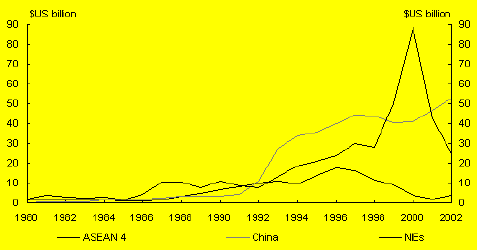Financial flows to East Asia have changed markedly in size and composition over the last decade. Foreign direct investment now dominates capital inflows with new foreign bank lending and portfolio investment remaining subdued. Foreign direct investment to China has grown rapidly since the early 1990s and competition within East Asia for foreign investment is intensifying. This article considers the factors that have influenced capital flows into East Asia over the past decade, with an emphasis on foreign direct investment.
East Asia’s economic development has relied on strong rates of capital accumulation over the past 30 years.1 Inflows of foreign capital have supplemented the region’s large pool of domestic savings to fund investment, especially in Southeast Asia. The East Asian financial crisis brought to the fore the importance of appropriate policies to attract and sustain domestic and international flows of capital.
In the early 1990s, strong rates of economic growth and the liberalisation of investment regimes across much of East Asia spurred strong private capital inflows as foreign investors sought out high rates of return. The 1997-98 East Asian financial crisis saw a dramatic withdrawal of capital from the region as investors and firms fled. Flows have picked up gradually since then, albeit against the backdrop of the global economic downturn in 2001 and the end of the technology bubble (Chart 1).
Chart 1: Net private capital inflows(a)
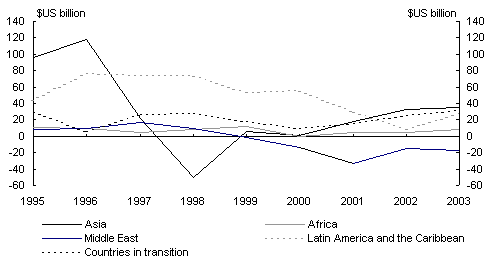
- The definition of Asia used by the IMF for net capital flows includes developing Pacific Island economies, South Asian and Central Asian developing economies as well as the East Asian economies discussed in this paper.
Source: IMF World Economic Outlook, September 2003.
Still, for many regional economies, inflows of foreign capital remain well below pre-crisis levels. Portfolio investment is showing recent signs of recovery, but lending by foreign banks to the region remains flat, at best. Inflows of foreign direct investment (FDI) to East Asia have intensified in recent years, in large part drawn by China’s low labour costs, strong growth and its entry into the World Trade Organisation.
This article examines trends in foreign capital flows, with a primary focus on developments in FDI. It discusses the development of FDI as the key source of capital flow to East Asia and the role that FDI has played and is playing in the development of East Asian economies. China’s role as the major regional recipient of global FDI and as an important driver of intra-regional FDI are also considered. The paper also briefly discusses portfolio and bank lending, alternative sources of finance for the region, but which have fallen in relative importance since the East Asian financial crisis.
Foreign direct investment
Foreign direct investment into East Asia increased substantially over the past two decades in response to sustained strong growth, economic development and market liberalisation. By 1993, non-Japan East Asia was receiving over 60percent of developing country FDI inflows and over one-fifth of global FDI.
Post-crisis, the sale of distressed banking and corporate assets drove a temporary surge in regional FDI, but excluding China, the region has struggled to attract consistent strong inflows of new FDI since. Global FDI flows tripled between 1997 and 2000, driven by a boom in merger and acquisition activity, mainly between the United States and Europe (Chart2). Over the same period, FDI to non-Japan East Asia also continued to grow rapidly, although East Asia’s share of global flows fell to just under 10percent, and its share of developing country FDI fell to around 55percent.
Chart 2: Global net inflows of foreign direct investment
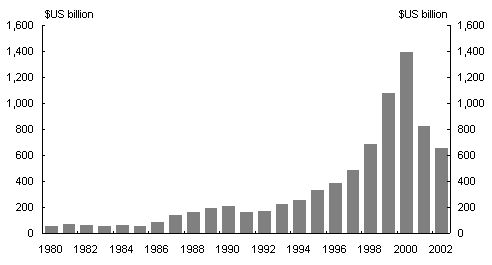
Source: United Nations Conference on Trade and Development, World Investment Report 2003.
Over the last two years, global FDI flows have fallen significantly, in line with the slowing global economy and the drying up of merger and acquisition activity across developed countries. FDI to East Asia has also eased, although not to the same degree and remains the dominant form of foreign capital inflow.
The role of FDI in the development of East Asia
Historically, Japan, Korea and Taiwan have not had a strong reliance on FDI, as domestic firms dominated the export sector and governments preferred to rely on strategic alliances and the importation of capital goods as a means of acquiring skills and technology. Over the period 1989-94, FDI contributed 5.6percent to fixed investment in Northeast Asia (Japan, Korea, Taiwan and Hong Kong), and 13.3percent in ASEAN 5 (Singapore, Malaysia, Indonesia, Thailand and the Philippines). By the late 1990s, this pattern had changed. FDI was contributing around 17percent to fixed investment in Northeast Asia, and 19percent in the ASEAN 5. Northeast Asian economies have become more open to FDI as service sectors have become more important, and as FDI restrictions were liberalised in the wake of the financial crisis, especially in Korea.
FDI has always played a significant role in the economic development of Southeast Asia, especially Singapore. In 2002, Indonesia’s stock of FDI to GDP ratio was 32percent, Malaysia’s 60percent, Thailand’s 24percent and Singapore’s 143percent. But inflows to Southeast Asia were disrupted by the financial crisis and inflows have yet to return to their pre-crisis levels. In Indonesia, there has been a net outflow of FDI since 1998 although the rate of disinvestment is easing. FDI flows to Malaysia and the Philippines picked up slightly in 2002, but remain well below pre-crisis levels.
FDI is playing an important role in the economic development of China — China’s FDI to GDP ratio was around 35percent in 2002 — and FDI inflows continue to be very strong. China offers many of the conditions that investors like, certainty of decision making, high skill levels, a large and strongly growing domestic market, and cheap labour. But at just 11percent of fixed investment, FDI flows remain small as a share of overall capital formation.
Sources of FDI
The newly industrialised economies (NIEs) of Singapore, Korea, Taiwan and Hong Kong and the ASEAN 4 (Malaysia, Indonesia, Thailand and the Philippines) have tended to source investment from outside the region. On the other hand, investment to China has predominately been from within the region, mainly from Taiwan and Hong Kong.
The US is a major source of FDI for the region. Around 16percent of US net FDI went to East Asia in 2002. In the first six months of 2003, US FDI flows into East Asia are below levels recorded over the same period in 2002, with the exception of Malaysia and Taiwan (Chart 3). This reflects the weak US economy, the inherent lumpiness of FDI data, and the impact of SARS on East Asia in the first half of 2003.
In recent years, the US has concentrated its investment in the NIEs, particularly in the IT and financial service sectors. But the US (along with Europe) is also an important investor in ASEAN and, at the same time, the US has not significantly increased its investment within China. Indeed, ASEAN receives more FDI from the United States than does China.
Chart 3: United States net foreign direct investment to East Asia
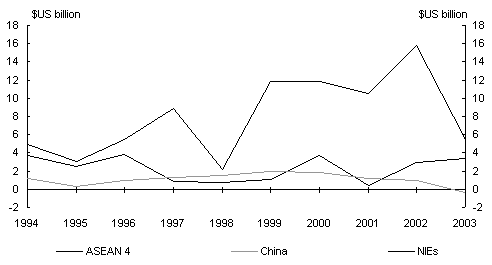
Note: Data for
2003 is for the six months to June 2003, annualised.
Source: United States Bureau of Economic Analysis.
Japan has been a key global source and the largest regional source of FDI and bank lending to East Asia. Rapid growth and industrialisation saw Japanese multinationals seek increased market share offshore and establish manufacturing production chains in the NIEs and Southeast Asia in response to rising production costs at home.
Investment flows slowed in the wake of the Asian financial crisis as financial sector problems in Japan, and the region’s structural weaknesses and poor growth led to a rationalisation of Japanese foreign investment and a contraction in Japanese lending abroad.
Chart 4: Japanese foreign direct investment to East Asia
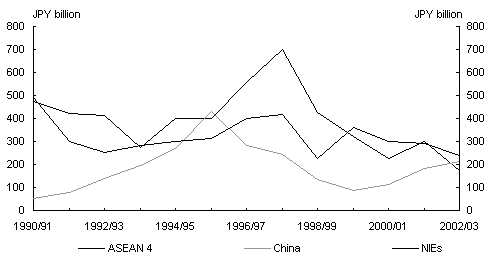
Note: FDI flows for Japan are gross values.
Source: Japanese Ministry of Finance.
Data from Japan’s Ministry of Finance show that by 2002, around 15percent of Japan’s FDI went to the rest of East Asia — around the same as Japan’s investment to Latin America. The manufacturing sector accounts for around two-thirds of Japan’s direct investment in East Asia, part of the ‘hollowing out’ of Japanese manufacturing.
Around one-third of Japan’s FDI to the region is directed to China — primarily aimed at the production of goods for export to Japan and third country markets. However, Japanese manufacturers are increasingly investing in China with a view to servicing and developing their market share in the Chinese domestic market.
Compared with China, Southeast Asia appears to be attracting increasingly less FDI from Japan, even though Japan’s flows to China are currently lower than in the mid 1990s (Chart 4). This reflects Japanese firms shifting their low-cost production bases away from Southeast Asia, especially Malaysia and Indonesia, to China. However, Southeast Asia’s transport equipment and electrical sectors continue to attract significant Japanese investment flows.
Annual surveys of Japanese manufacturers foreign investment intentions undertaken by the Ministry of Economy, Trade and Industry suggest that while China is the preferred destination for new investment, Japanese multinationals will continue to be involved Southeast Asia, given their established supplier networks, strategic alliances and sunk investment. Japan has a considerable stock of investment in ASEAN — more than three times that of China.
At the same time Korea, Hong Kong and Taiwan appear to be losing out to China — Japanese FDI flows to these countries have been on a downward trend since the late 1990s (Chart 4).
Intra-regional investment
Trade and investment flows are creating a virtuous cycle in the region. While inflows from major developed economies, especially the US and Japan, continue to be important for the region, the expansion of trade linkages and the development of regional trading arrangements are increasing intra-regional investment flows.
While Japan is still the main intra-regional source of FDI, Taiwan, Hong Kong and Korea are important sources of FDI to China and the ASEAN economies as they continue to relocate their labour-intensive manufacturing production to these lower cost economies. Similar to Japan, these economies are moving to establish new production bases in China across a wide array of higher value-added manufacturing sectors.
Intra-ASEAN FDI is also expanding, growing from 7percent of GDP in 1999 to 17percent of GDP in 2002, and should continue to grow as integration of trade and investment flows develop further.
|
Box 1: China’s role in the region China is the largest developing country recipient of FDI and since 1992 has received more global FDI inflows than the ASEAN 4 economies combined, much of it from other Northeast Asian economies. In 2002, China was the largest global recipient of FDI, overtaking the US. China received 33percent of global developing country inflows in 2002 and accounted for 60percent of FDI inflows to East Asia. Furthermore, FDI to China increased slightly, even as the weak global economy saw global flows fall (Chart A). Chart A: Inflows of net foreign direct investment to East Asia(a)
Source: United Nations Conference on Trade and Development, World Investment Report 2003. The stock of FDI in China is now around $US450billion (almost 40percent of GDP), and has grown by over $US40billion per year since 1996. But the magnitude of inflows to China may be overstated. The surge in FDI from the early 1990s may be due, in part, to ‘round-tripping’ as Chinese funds were channelled through overseas markets back to the mainland to access government incentives that were only available to ‘foreign’ investors. The World Bank notes that around 25percent of China’s FDI inflow may be due to round-tripping. |
|
Box 1: China’s role in the region (continued) Demonstrating the importance of foreign investment, and its export orientation to the Chinese economy, foreign–funded enterprises account for around 55percent of China’s exports. The share of total Chinese production attributed to foreign-funded enterprises was 34percent in 2002, compared with 2percent in 1990. China’s development as a source of capitalAt the same time, China is emerging as a source of investment. Recent data from the United Nation’s Conference on Trade and Development (UNCTAD) show that China’s role as an investor has been growing slowly but steadily since the start of the 1990s, overtaking the ASEAN 4 in 1995 as a source of FDI. China is now one of the top FDI exporters among developing countries — from a two year average of $US2.5 in 1991-92, China’s FDI outflows have grown to almost $US5billion in 2001-02. Australia is also benefiting from China’s outward investment. As at June 2002, China was the thirteenth largest investor in Australia with a stock of investment worth $A2.9 billion, up from $A1.2 billion in 1997. Most of China’s Australian investments are in the resource and property sectors. |
Portfolio investment
East Asian equity prices almost doubled between 1991 and 1996, before falling substantially during the 1997-98 East Asian financial crisis. The fall in equity prices reflected the large-scale withdrawal of international and domestic investors. This was especially apparent in Thailand where equity prices fell almost 80percent between 1996 and 1998 (Chart 5). Regional equity markets have shown little sustained strength in the six years since the crisis, with most hovering around their pre-crisis level. However, more recently, equity markets have been improving in line with improved regional growth prospects and stronger global markets.
Since the start of 2003, equity markets in the developing economies of Southeast Asia have grown more strongly than the more industrialised economies of Korea, Singapore, Hong Kong and Taiwan. This reflects stronger economic growth since mid-2002 in Southeast Asia, the effects of the SARS epidemic on Singapore, Hong Kong and Taiwan in the first half of 2003, and corporate-sector difficulties and poor GDP
growth in Korea.
The surge in portfolio investment into Thailand and Indonesia has been particularly strong, growing by 50 to 60percent since the start of the year. While portfolio flows into these economies are being fuelled by a turnaround in sentiment, the strong growth was off a low base.
Chart 5: East Asian equity markets
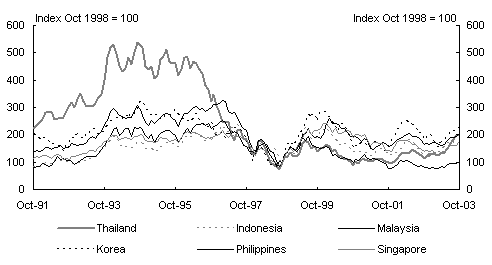
Source: Datastream.
Bank lending
Foreign bank lending to East Asia has fallen considerably in the years following the financial crisis, with the continued withdrawal of Japanese banks from the region especially significant (Chart 6). The decline in foreign willingness to lend to East Asia has not been restricted to lenders from any particular region. More recently, lending from Japanese banks has stabilised at low levels while lending from US and European banks has remained flat.
Chart 6: Sources of consolidated claims
by foreign banks on East Asia
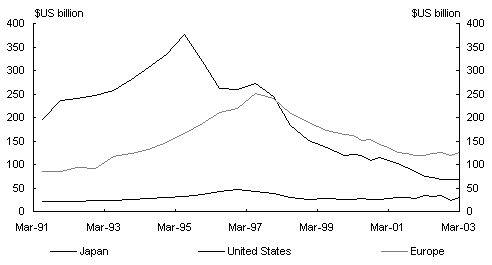
Note: Europe includes: Austria, Belgium, Denmark, Finland, France, Germany, Ireland, Italy, the Netherlands, Portugal, Spain, Sweden and The United Kingdom.
Source: Bank for International Settlements: Consolidated International Banking Statistics.
A large portion of the fall in foreign bank lending to East Asia reflects falls in lending to the major East Asian financial centres of Hong Kong and Singapore by Japanese banks (Chart 7). The large fall in lending by Japanese banks that started in 1995 reflected wide-spread problems in the Japanese financial sector. Initially, the decline in Japanese lending to East Asia was partially offset by increased lending from Europe. However, the East Asian financial crisis in 1997-98 saw lending fall from Europe.
|
Chart 7: Claims by foreign banks on East Asian economies |
|
|
|
|
Source: Bank for International Settlements: Consolidated International Banking Statistics.
Concluding comments
The increased integration of regional production means that most East Asian economies will continue to attract and benefit from inter and intra-regional investment flows. Intense competition for funds is also likely to lead governments to adopt more liberal investment regimes.
Foreign direct investment will remain the main source of foreign capital for East Asia, and current discussions on regional trade agreements aimed at reducing barriers to investment should help this process. But to address the ongoing requirements for capital, reforms that promote sustainable capital inflows as well as the development of domestic capital markets are needed. These will help ensure domestic funds are allocated efficiently while limiting economies’ vulnerability to future fluctuations in capital flows. In this regard, measures to develop and deepen regional capital markets (e.g. the recently proposed regional bond market) are welcome developments that will aid in this process by enabling East Asia to better channel regional savings.
Domestic reforms — particularly the strengthening of financial systems and corporate governance frameworks to maintain investor confidence and encourage domestic savings to flow towards efficient investment — remain on-going objectives for governments in the region. A stable political environment and sound macroeconomic policies are also an important prerequisite for attracting investment flows. For Southeast Asia, conditions that support physical and personal security will also be key factors in determining their longer-term attractiveness to investment and sustained strong rates of GDP growth.
1 In this paper East Asia is Korea, Taiwan, Hong Kong, China, Indonesia, Thailand, Malaysia, Singapore and the Philippines.
